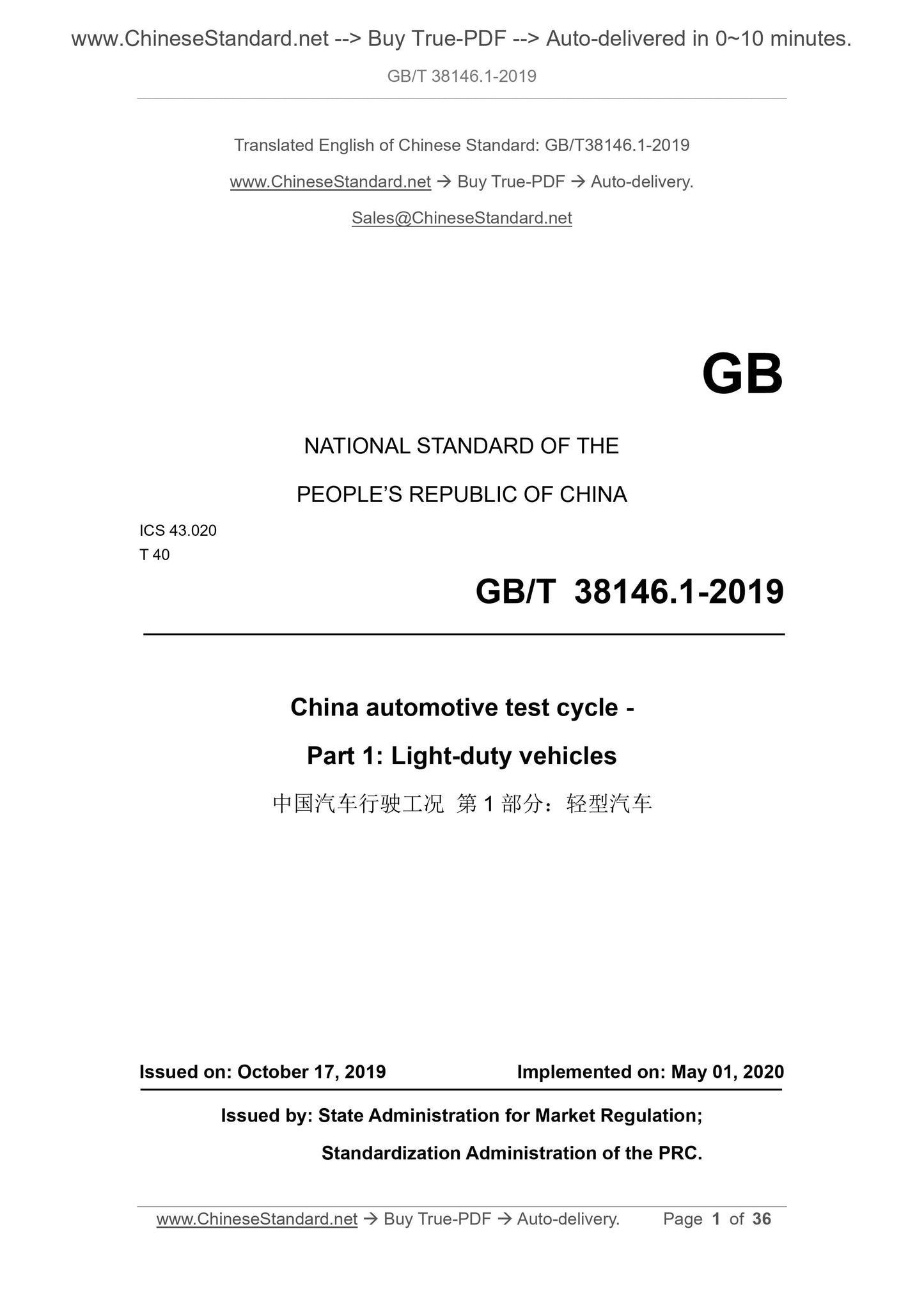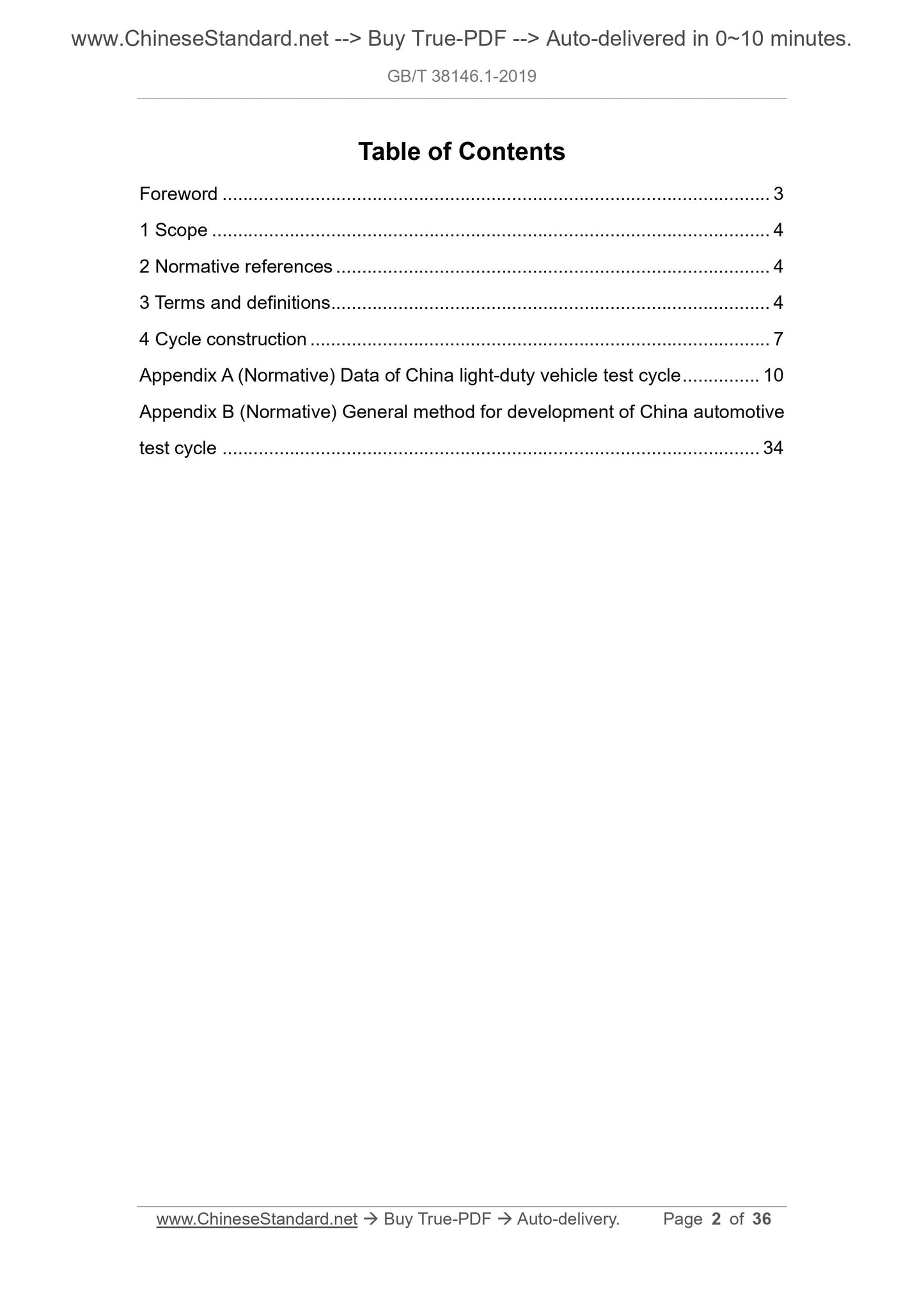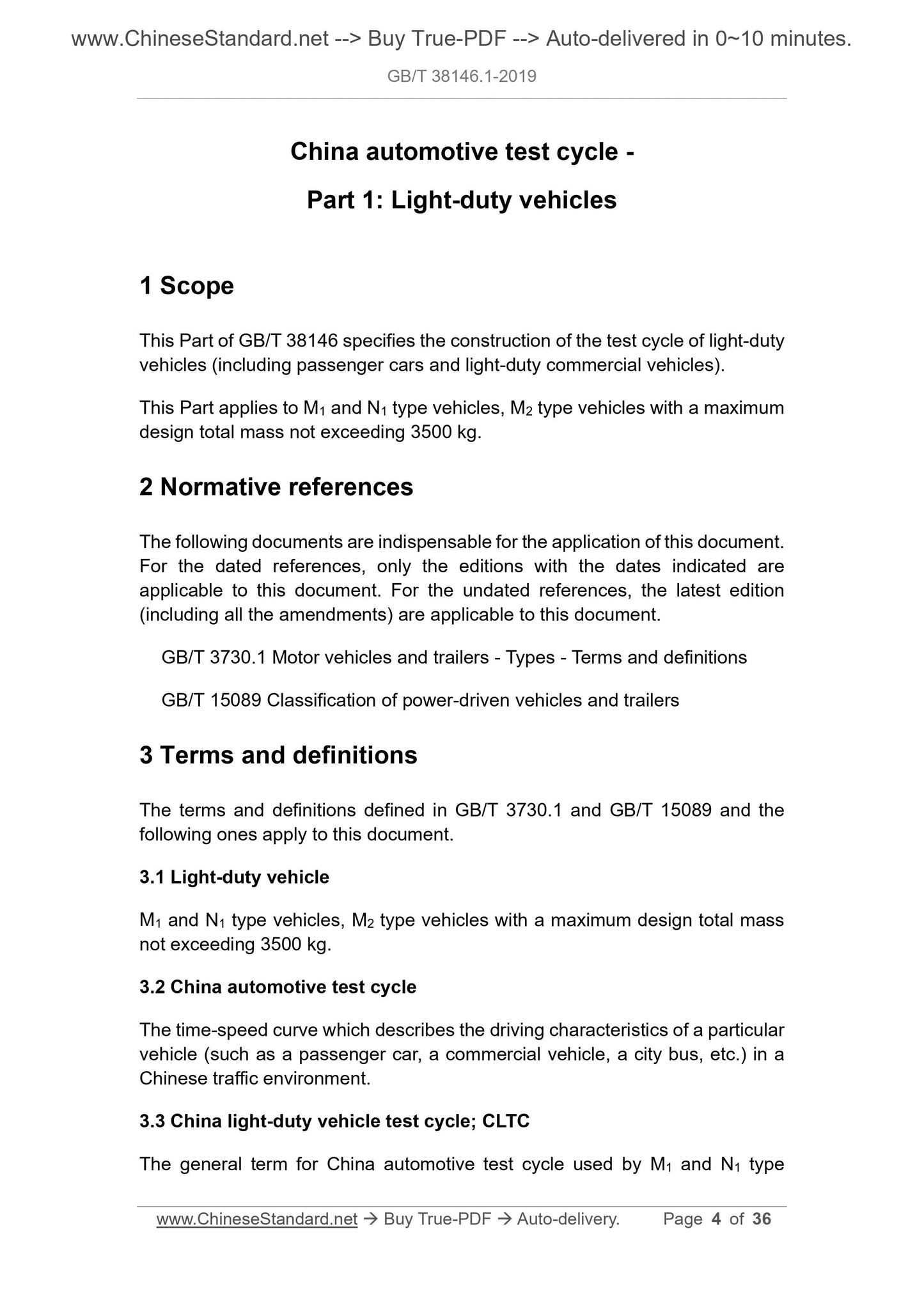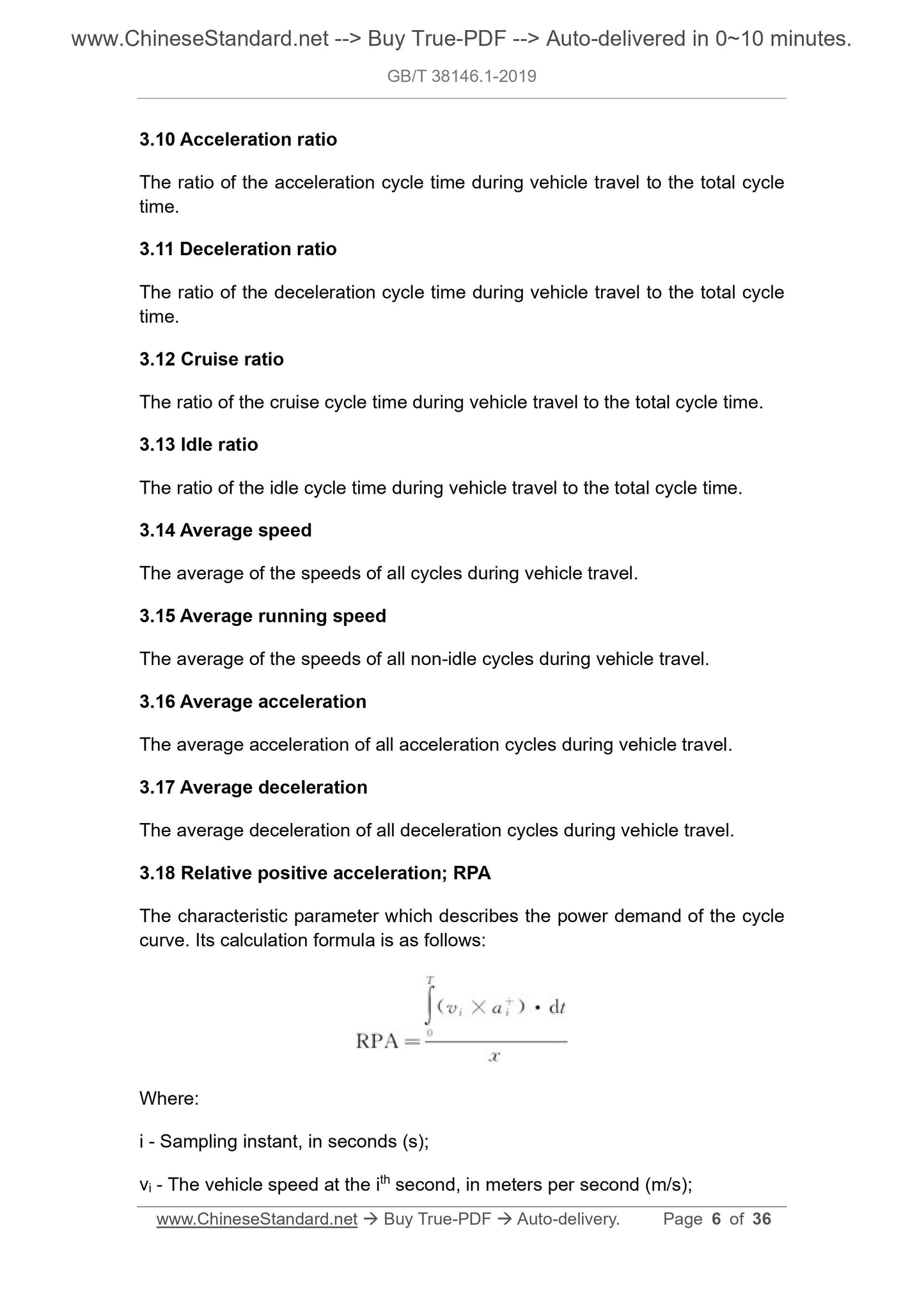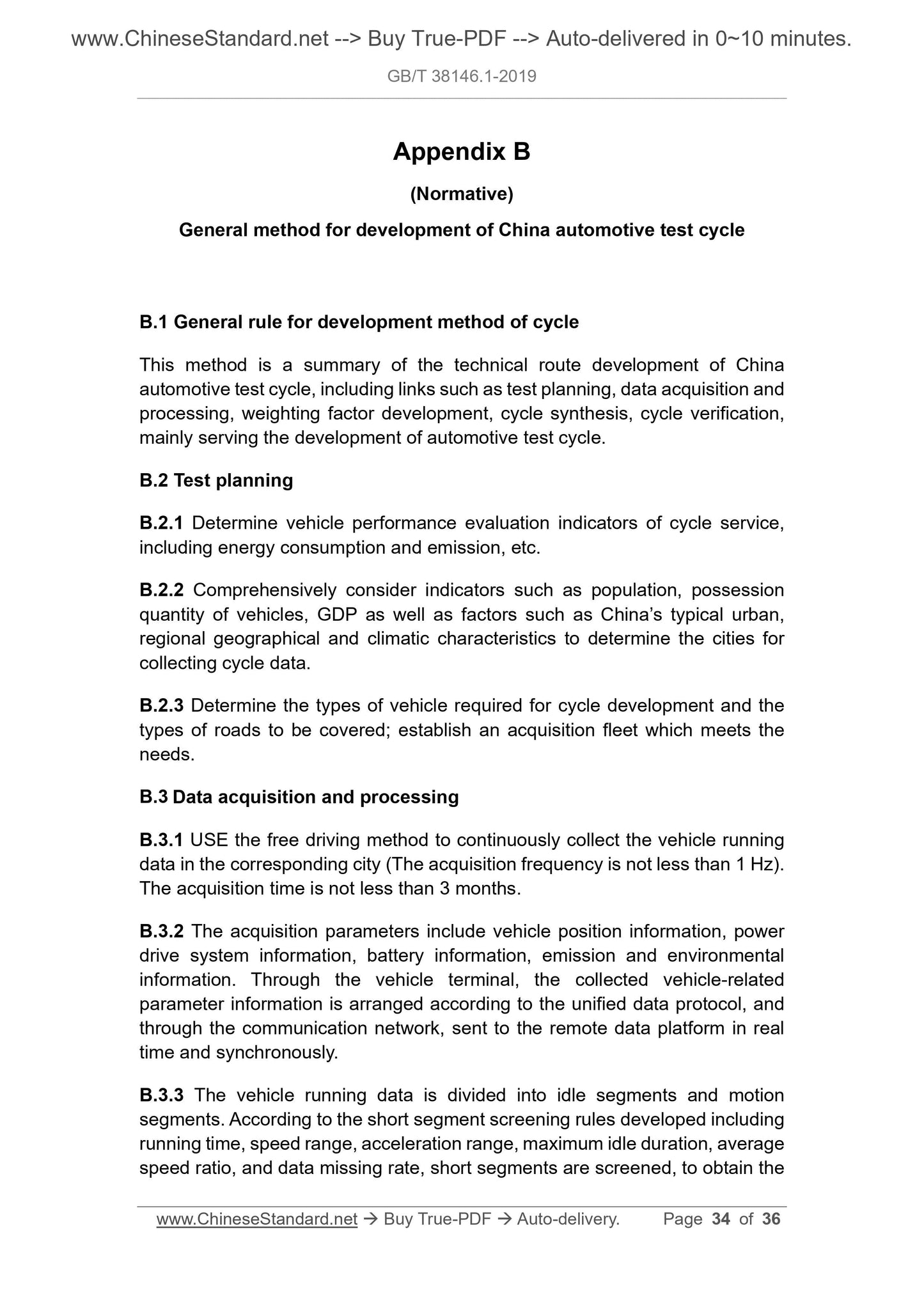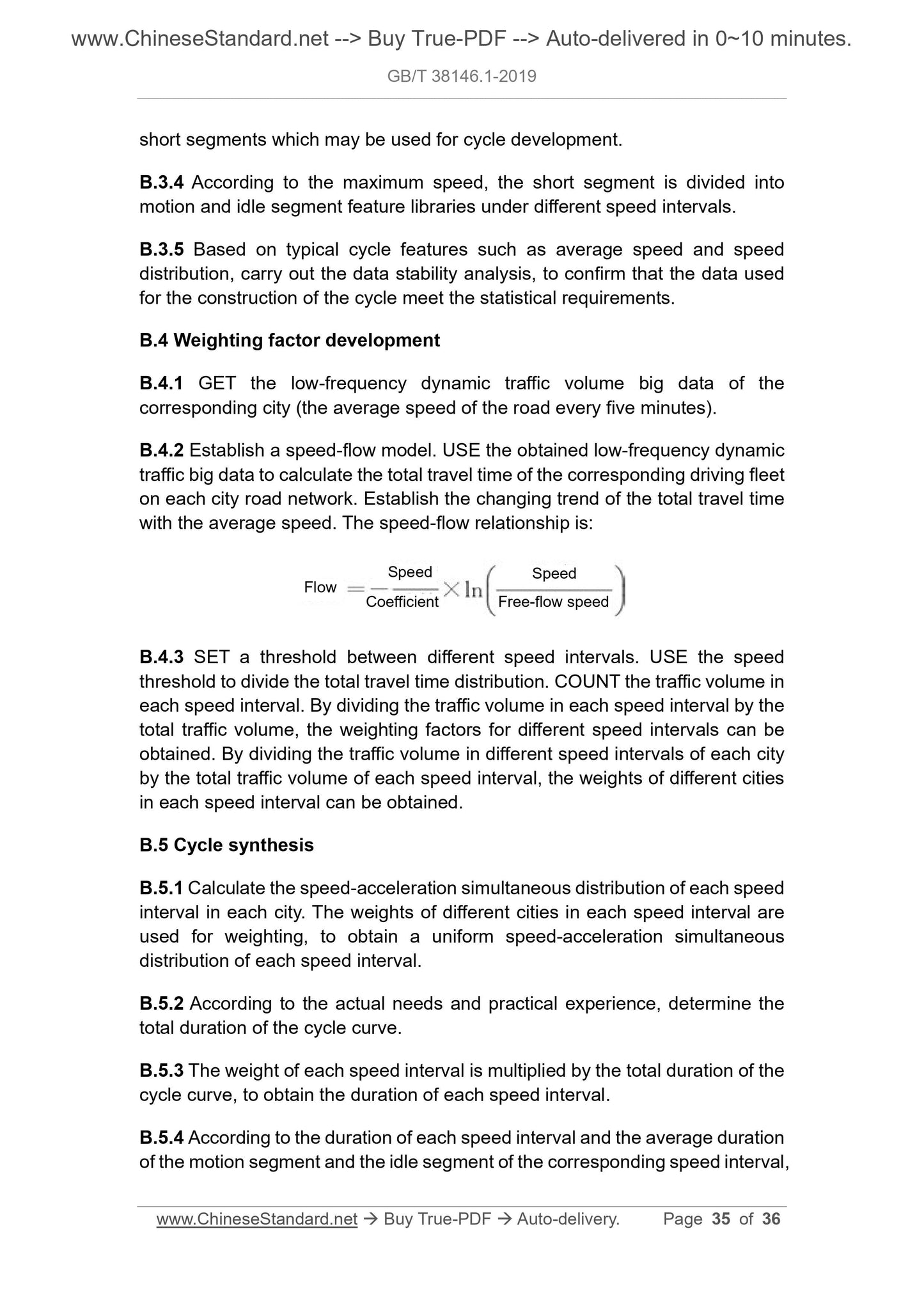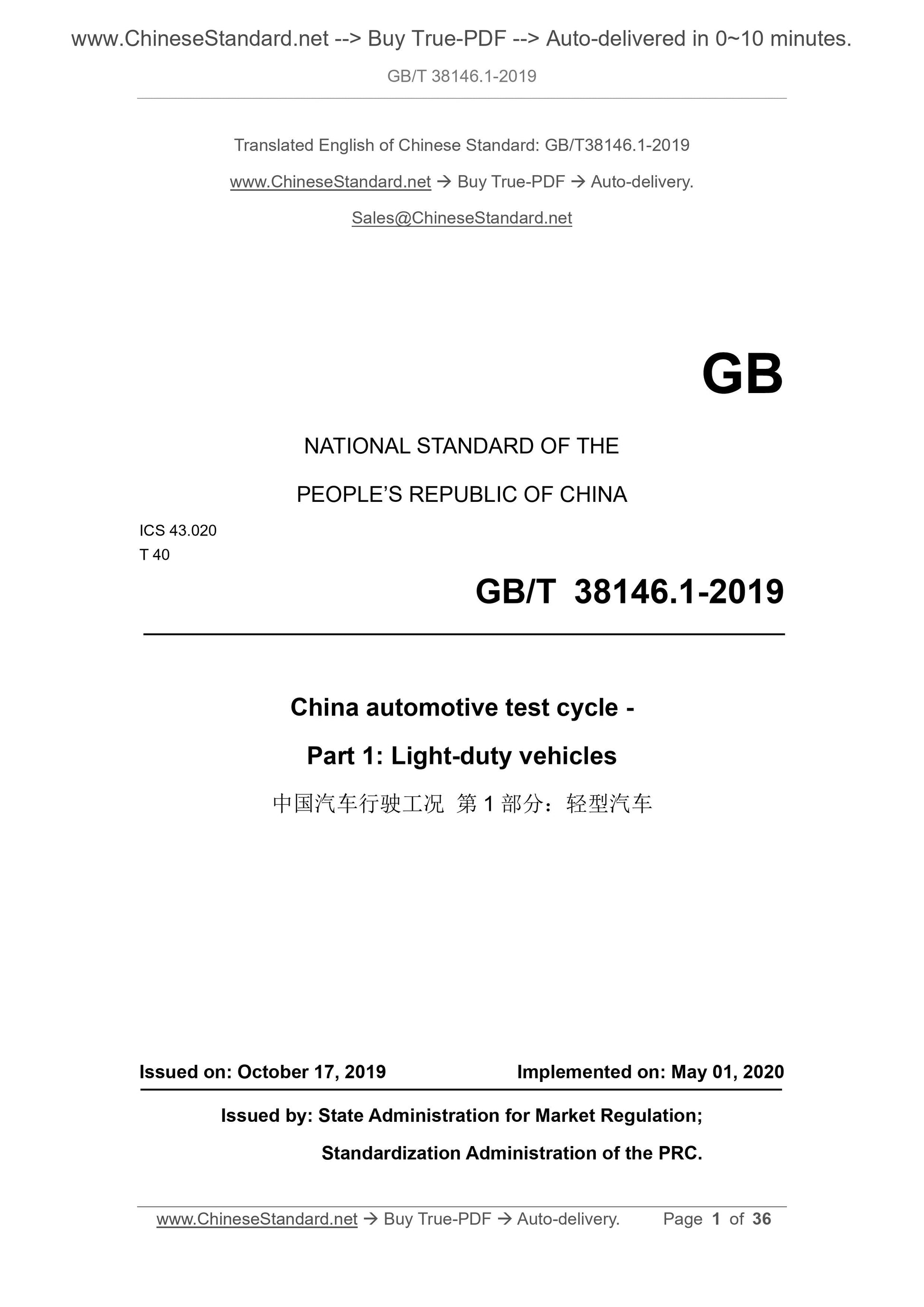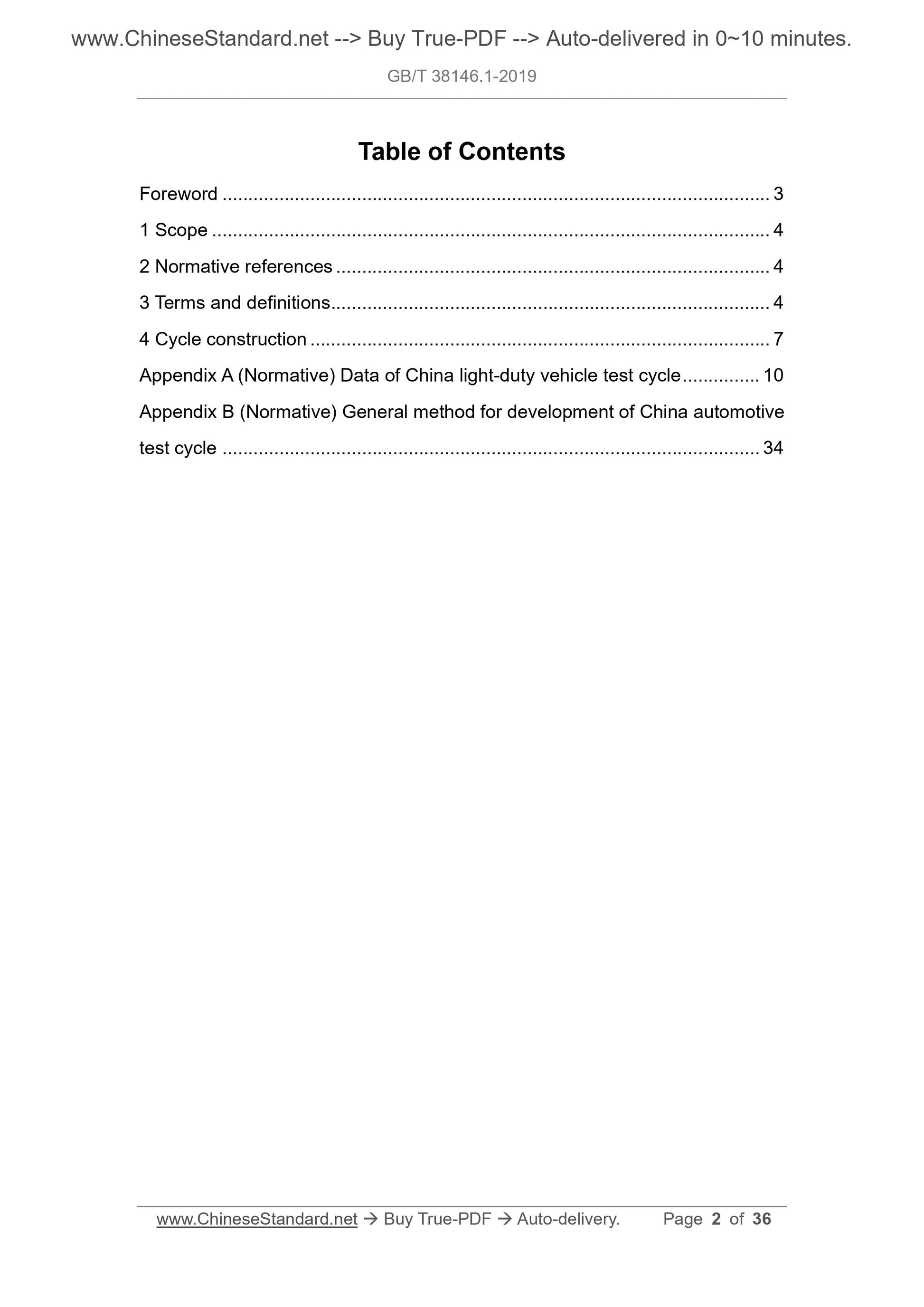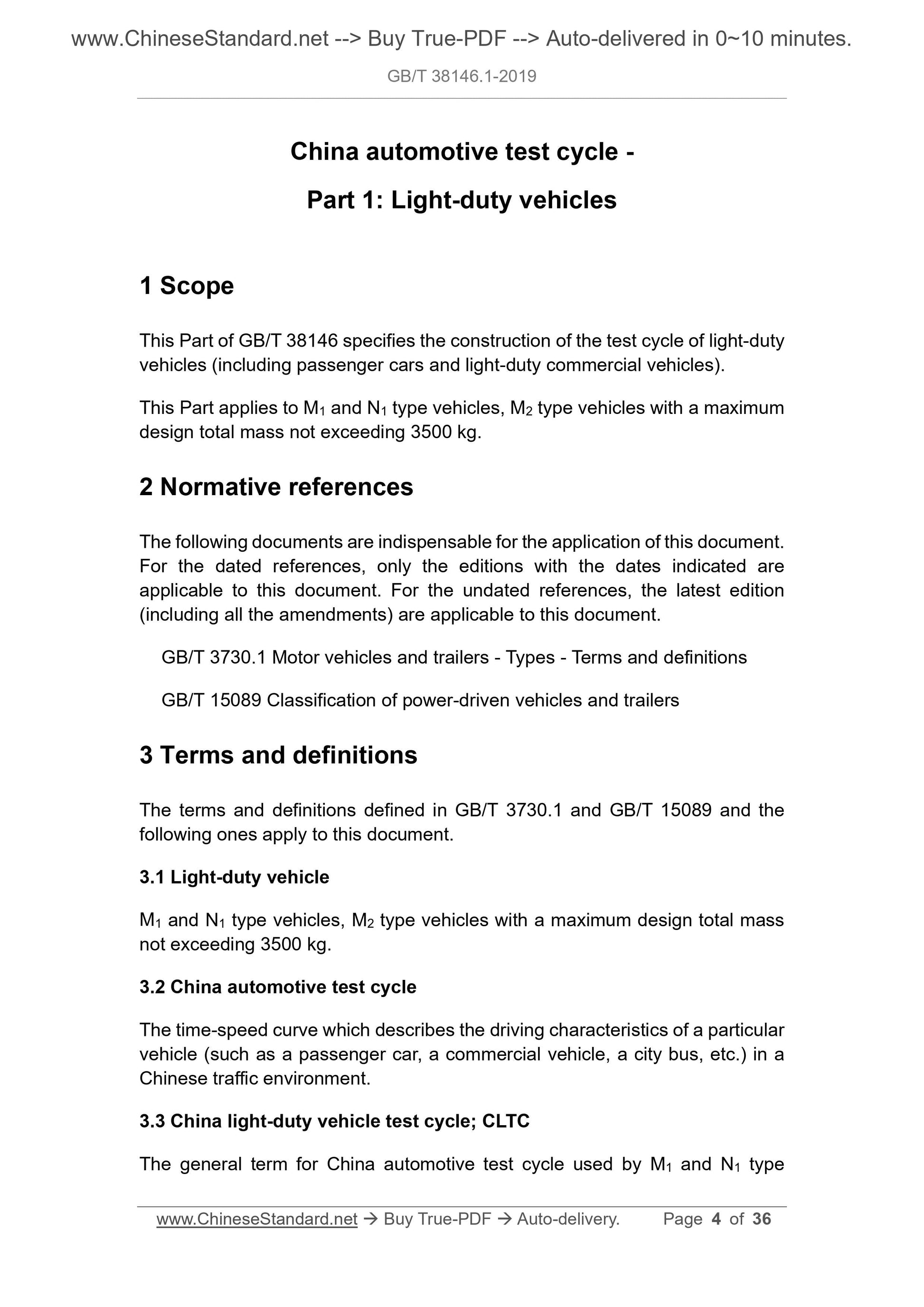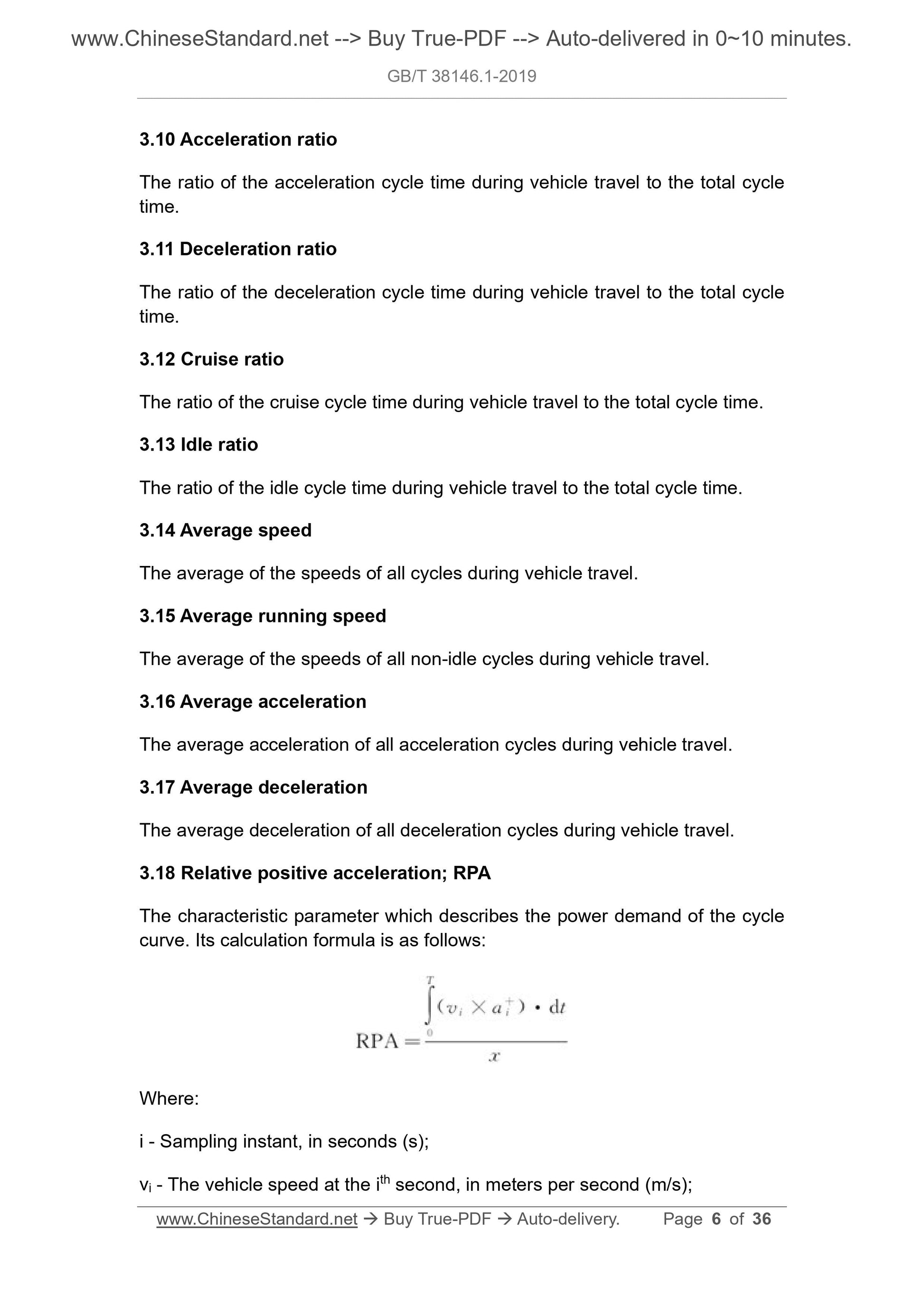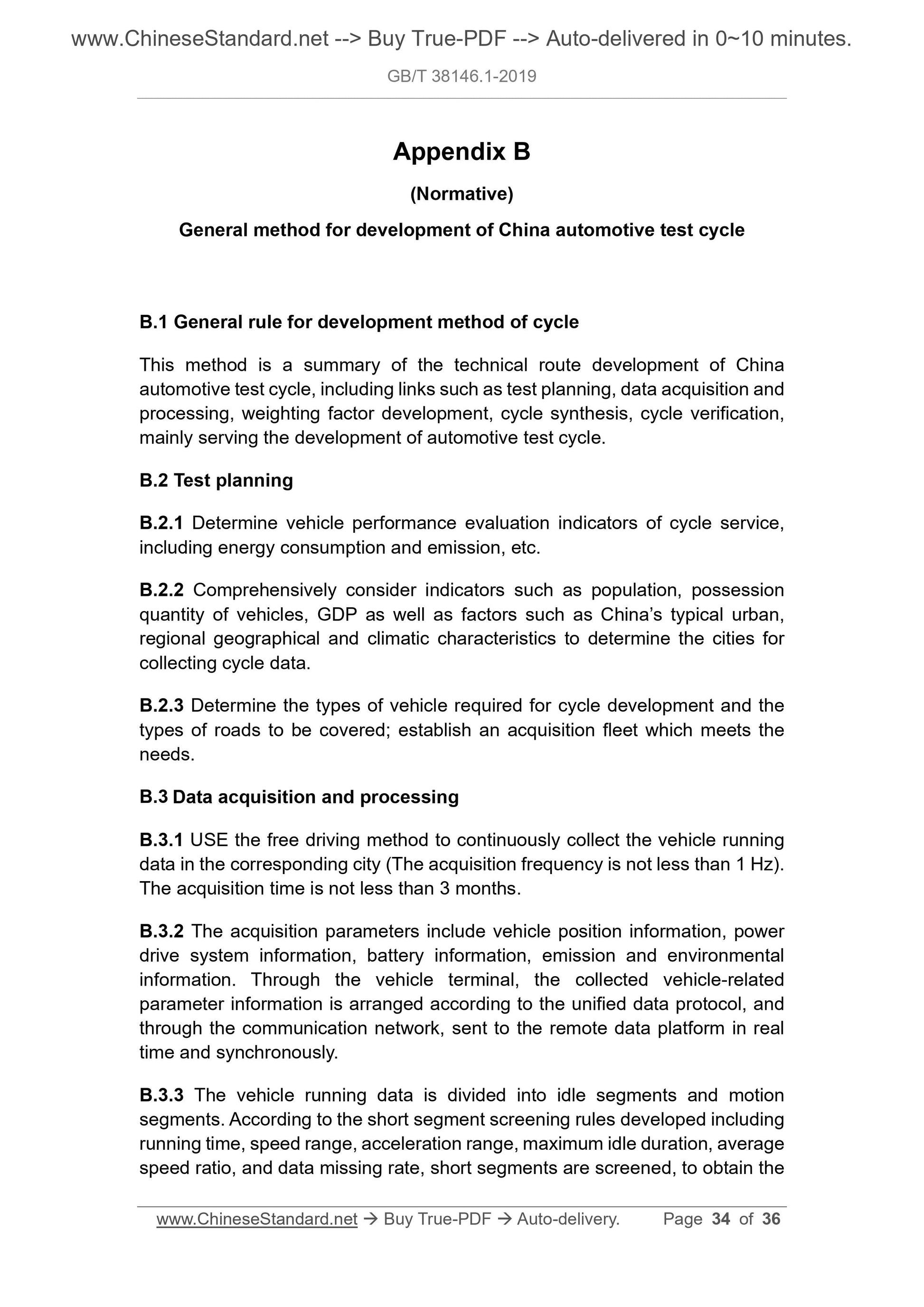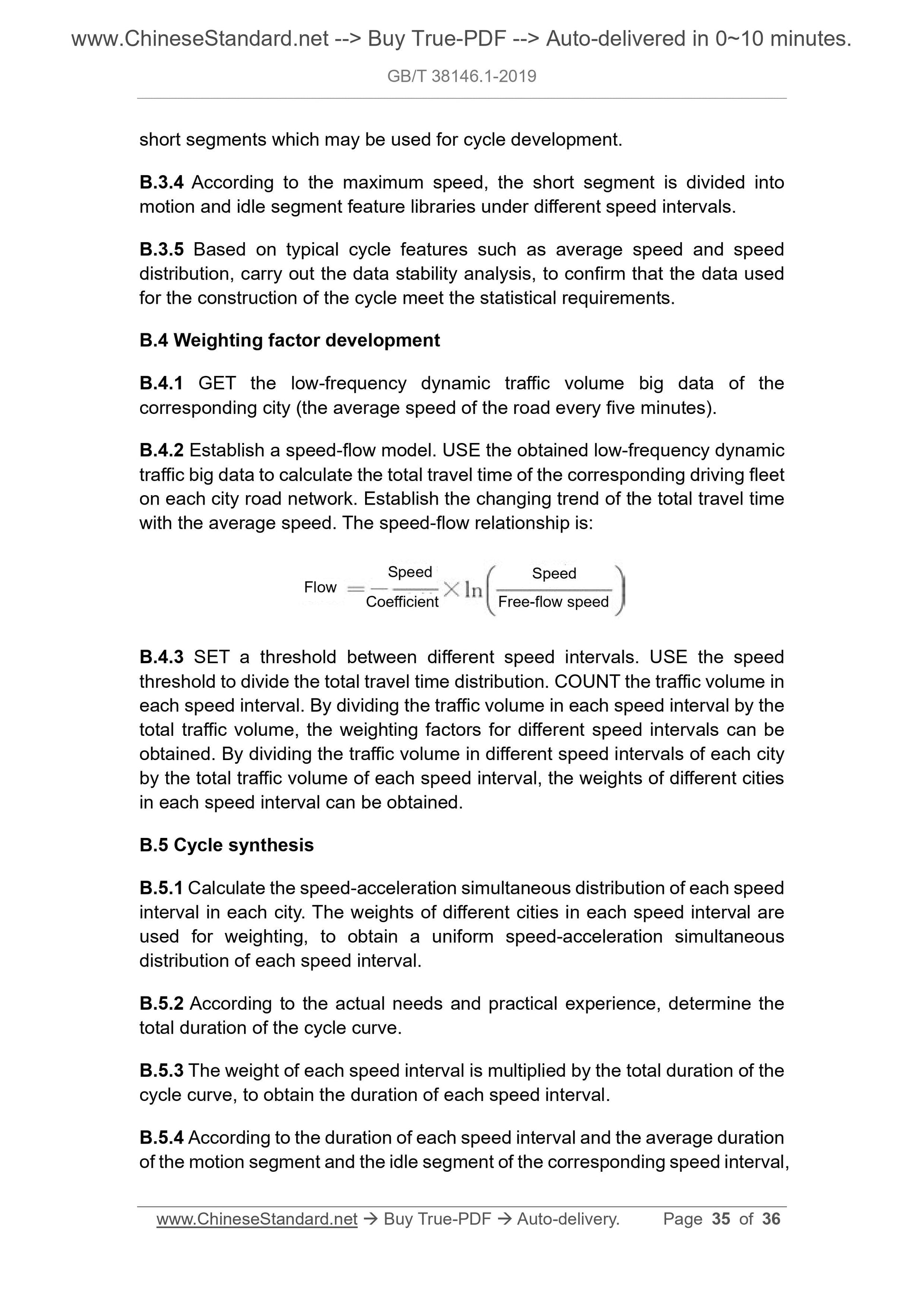1
/
of
6
PayPal, credit cards. Download editable-PDF and invoice in 1 second!
GB/T 38146.1-2019 English PDF (GBT38146.1-2019)
GB/T 38146.1-2019 English PDF (GBT38146.1-2019)
Regular price
$145.00 USD
Regular price
Sale price
$145.00 USD
Unit price
/
per
Shipping calculated at checkout.
Couldn't load pickup availability
Delivery: 3 seconds. Download true-PDF + Invoice.
Get QUOTATION in 1-minute: Click GB/T 38146.1-2019
Historical versions: GB/T 38146.1-2019
Preview True-PDF (Reload/Scroll if blank)
GB/T 38146.1-2019: China automotive test cycle -- Part 1: Light-duty vehicles
GB/T 38146.1-2019
NATIONAL STANDARD OF THE
PEOPLE’S REPUBLIC OF CHINA
ICS 43.020
T 40
China automotive test cycle -
Part 1: Light-duty vehicles
ISSUED ON: OCTOBER 17, 2019
IMPLEMENTED ON: MAY 01, 2020
Issued by: State Administration for Market Regulation;
Standardization Administration of the PRC.
Table of Contents
Foreword ... 3
1 Scope ... 4
2 Normative references ... 4
3 Terms and definitions ... 4
4 Cycle construction ... 7
Appendix A (Normative) Data of China light-duty vehicle test cycle ... 10
Appendix B (Normative) General method for development of China automotive
test cycle ... 34
China automotive test cycle -
Part 1: Light-duty vehicles
1 Scope
This Part of GB/T 38146 specifies the construction of the test cycle of light-duty
vehicles (including passenger cars and light-duty commercial vehicles).
This Part applies to M1 and N1 type vehicles, M2 type vehicles with a maximum
design total mass not exceeding 3500 kg.
2 Normative references
The following documents are indispensable for the application of this document.
For the dated references, only the editions with the dates indicated are
applicable to this document. For the undated references, the latest edition
(including all the amendments) are applicable to this document.
GB/T 3730.1 Motor vehicles and trailers - Types - Terms and definitions
GB/T 15089 Classification of power-driven vehicles and trailers
3 Terms and definitions
The terms and definitions defined in GB/T 3730.1 and GB/T 15089 and the
following ones apply to this document.
3.1 Light-duty vehicle
M1 and N1 type vehicles, M2 type vehicles with a maximum design total mass
not exceeding 3500 kg.
3.2 China automotive test cycle
The time-speed curve which describes the driving characteristics of a particular
vehicle (such as a passenger car, a commercial vehicle, a city bus, etc.) in a
Chinese traffic environment.
3.3 China light-duty vehicle test cycle; CLTC
The general term for China automotive test cycle used by M1 and N1 type
3.10 Acceleration ratio
The ratio of the acceleration cycle time during vehicle travel to the total cycle
time.
3.11 Deceleration ratio
The ratio of the deceleration cycle time during vehicle travel to the total cycle
time.
3.12 Cruise ratio
The ratio of the cruise cycle time during vehicle travel to the total cycle time.
3.13 Idle ratio
The ratio of the idle cycle time during vehicle travel to the total cycle time.
3.14 Average speed
The average of the speeds of all cycles during vehicle travel.
3.15 Average running speed
The average of the speeds of all non-idle cycles during vehicle travel.
3.16 Average acceleration
The average acceleration of all acceleration cycles during vehicle travel.
3.17 Average deceleration
The average deceleration of all deceleration cycles during vehicle travel.
3.18 Relative positive acceleration; RPA
The characteristic parameter which describes the power demand of the cycle
curve. Its calculation formula is as follows:
Where:
i - Sampling instant, in seconds (s);
vi - The vehicle speed at the ith second, in meters per second (m/s);
Appendix B
(Normative)
General method for development of China automotive test cycle
B.1 General rule for development method of cycle
This method is a summary of the technical route development of China
automotive test cycle, including links such as test planning, data acquisition and
processing, weighting factor development, cycle synthesis, cycle verification,
mainly serving the development of automotive test cycle.
B.2 Test planning
B.2.1 Determine vehicle performance evaluation indicators of cycle service,
including energy consumption and emission, etc.
B.2.2 Comprehensively consider indicators such as population, possession
quantity of vehicles, GDP as well as factors such as China’s typical urban,
regional geographical and climatic characteristics to determine the cities for
collecting cycle data.
B.2.3 Determine the types of vehicle required for cycle development and the
types of roads to be covered; establish an acquisition fleet which meets the
needs.
B.3 Data acquisition and processing
B.3.1 USE the free driving method to continuously collect the vehicle running
data in the corresponding city (The acquisition frequency is not less than 1 Hz).
The acquisition time is not less than 3 months.
B.3.2 The acquisition parameters include vehicle position information, power
drive system information, battery information, emission and environmental
information. Through the vehicle terminal, the collected vehicle-related
parameter information is arranged according to the unified data protocol, and
through the communication network, sent to the remote data platform in real
time and synchronously.
B.3.3 The vehicle running data is divided into idle segments and motion
segments. According to the short segment screening rules developed including
running time, speed range, acceleration range, maximum idle duration, average
speed ratio, and data missing rate, short segments are screened, to obtain the
short segments which may be used for cycle development.
B.3.4 According to the maximum speed, the short segment is divided into
motion and idle segment feature libraries under different speed intervals.
B.3.5 Based on typical cycle features such as average speed and speed
distribution, carry out the data stability analysis, to confirm that the data used
for the construction of the cycle meet the statistical requirements.
B.4 Weighting factor development
B.4.1 GET the low-frequency dynamic traffic volume big data of the
corresponding city (the average speed of the road every five minutes).
B.4.2 Establish a speed-flow model. USE the obtained low-frequency dynamic
traffic big data to calculate the total travel time of the corresponding driving fleet
on each city road network. Establish the changing trend of the total travel time
with the average speed. The speed-flow relationship is:
B.4.3 SET a threshold between different speed intervals. USE the speed
threshold to divide the total travel time distribution. COUNT the traffic volume in
each speed interval. By dividing the traffic volume in each speed interval by the
total traffic volume, the weighting factors for different speed intervals can be
obtained. By dividing the traffic volume in different speed intervals of each city
by the total traffic volume of each speed interval, the weights of different cities
in each speed interval can be obtained.
B.5 Cycle synthesis
B.5.1 Calculate the speed-acceleration simultaneous distribution of each speed
interval in each city. The weights of different cities in each speed interval are
used for weighting, to obtain a uniform speed-acceleration simultaneous
distribution of each speed interval.
B.5.2 According to the actual needs and practical experience, determine the
total duration of the cycle curve.
B.5.3 The weight of each speed interval is multiplied by the total duration of the
cycle curve, to obtain the duration of each speed interval.
B.5.4 According to the duration of each speed interval and the average duration
of the motion segment and the idle segment of the corresponding speed interval,
Flow Speed Coefficient
Speed
Free-flow speed
Get QUOTATION in 1-minute: Click GB/T 38146.1-2019
Historical versions: GB/T 38146.1-2019
Preview True-PDF (Reload/Scroll if blank)
GB/T 38146.1-2019: China automotive test cycle -- Part 1: Light-duty vehicles
GB/T 38146.1-2019
NATIONAL STANDARD OF THE
PEOPLE’S REPUBLIC OF CHINA
ICS 43.020
T 40
China automotive test cycle -
Part 1: Light-duty vehicles
ISSUED ON: OCTOBER 17, 2019
IMPLEMENTED ON: MAY 01, 2020
Issued by: State Administration for Market Regulation;
Standardization Administration of the PRC.
Table of Contents
Foreword ... 3
1 Scope ... 4
2 Normative references ... 4
3 Terms and definitions ... 4
4 Cycle construction ... 7
Appendix A (Normative) Data of China light-duty vehicle test cycle ... 10
Appendix B (Normative) General method for development of China automotive
test cycle ... 34
China automotive test cycle -
Part 1: Light-duty vehicles
1 Scope
This Part of GB/T 38146 specifies the construction of the test cycle of light-duty
vehicles (including passenger cars and light-duty commercial vehicles).
This Part applies to M1 and N1 type vehicles, M2 type vehicles with a maximum
design total mass not exceeding 3500 kg.
2 Normative references
The following documents are indispensable for the application of this document.
For the dated references, only the editions with the dates indicated are
applicable to this document. For the undated references, the latest edition
(including all the amendments) are applicable to this document.
GB/T 3730.1 Motor vehicles and trailers - Types - Terms and definitions
GB/T 15089 Classification of power-driven vehicles and trailers
3 Terms and definitions
The terms and definitions defined in GB/T 3730.1 and GB/T 15089 and the
following ones apply to this document.
3.1 Light-duty vehicle
M1 and N1 type vehicles, M2 type vehicles with a maximum design total mass
not exceeding 3500 kg.
3.2 China automotive test cycle
The time-speed curve which describes the driving characteristics of a particular
vehicle (such as a passenger car, a commercial vehicle, a city bus, etc.) in a
Chinese traffic environment.
3.3 China light-duty vehicle test cycle; CLTC
The general term for China automotive test cycle used by M1 and N1 type
3.10 Acceleration ratio
The ratio of the acceleration cycle time during vehicle travel to the total cycle
time.
3.11 Deceleration ratio
The ratio of the deceleration cycle time during vehicle travel to the total cycle
time.
3.12 Cruise ratio
The ratio of the cruise cycle time during vehicle travel to the total cycle time.
3.13 Idle ratio
The ratio of the idle cycle time during vehicle travel to the total cycle time.
3.14 Average speed
The average of the speeds of all cycles during vehicle travel.
3.15 Average running speed
The average of the speeds of all non-idle cycles during vehicle travel.
3.16 Average acceleration
The average acceleration of all acceleration cycles during vehicle travel.
3.17 Average deceleration
The average deceleration of all deceleration cycles during vehicle travel.
3.18 Relative positive acceleration; RPA
The characteristic parameter which describes the power demand of the cycle
curve. Its calculation formula is as follows:
Where:
i - Sampling instant, in seconds (s);
vi - The vehicle speed at the ith second, in meters per second (m/s);
Appendix B
(Normative)
General method for development of China automotive test cycle
B.1 General rule for development method of cycle
This method is a summary of the technical route development of China
automotive test cycle, including links such as test planning, data acquisition and
processing, weighting factor development, cycle synthesis, cycle verification,
mainly serving the development of automotive test cycle.
B.2 Test planning
B.2.1 Determine vehicle performance evaluation indicators of cycle service,
including energy consumption and emission, etc.
B.2.2 Comprehensively consider indicators such as population, possession
quantity of vehicles, GDP as well as factors such as China’s typical urban,
regional geographical and climatic characteristics to determine the cities for
collecting cycle data.
B.2.3 Determine the types of vehicle required for cycle development and the
types of roads to be covered; establish an acquisition fleet which meets the
needs.
B.3 Data acquisition and processing
B.3.1 USE the free driving method to continuously collect the vehicle running
data in the corresponding city (The acquisition frequency is not less than 1 Hz).
The acquisition time is not less than 3 months.
B.3.2 The acquisition parameters include vehicle position information, power
drive system information, battery information, emission and environmental
information. Through the vehicle terminal, the collected vehicle-related
parameter information is arranged according to the unified data protocol, and
through the communication network, sent to the remote data platform in real
time and synchronously.
B.3.3 The vehicle running data is divided into idle segments and motion
segments. According to the short segment screening rules developed including
running time, speed range, acceleration range, maximum idle duration, average
speed ratio, and data missing rate, short segments are screened, to obtain the
short segments which may be used for cycle development.
B.3.4 According to the maximum speed, the short segment is divided into
motion and idle segment feature libraries under different speed intervals.
B.3.5 Based on typical cycle features such as average speed and speed
distribution, carry out the data stability analysis, to confirm that the data used
for the construction of the cycle meet the statistical requirements.
B.4 Weighting factor development
B.4.1 GET the low-frequency dynamic traffic volume big data of the
corresponding city (the average speed of the road every five minutes).
B.4.2 Establish a speed-flow model. USE the obtained low-frequency dynamic
traffic big data to calculate the total travel time of the corresponding driving fleet
on each city road network. Establish the changing trend of the total travel time
with the average speed. The speed-flow relationship is:
B.4.3 SET a threshold between different speed intervals. USE the speed
threshold to divide the total travel time distribution. COUNT the traffic volume in
each speed interval. By dividing the traffic volume in each speed interval by the
total traffic volume, the weighting factors for different speed intervals can be
obtained. By dividing the traffic volume in different speed intervals of each city
by the total traffic volume of each speed interval, the weights of different cities
in each speed interval can be obtained.
B.5 Cycle synthesis
B.5.1 Calculate the speed-acceleration simultaneous distribution of each speed
interval in each city. The weights of different cities in each speed interval are
used for weighting, to obtain a uniform speed-acceleration simultaneous
distribution of each speed interval.
B.5.2 According to the actual needs and practical experience, determine the
total duration of the cycle curve.
B.5.3 The weight of each speed interval is multiplied by the total duration of the
cycle curve, to obtain the duration of each speed interval.
B.5.4 According to the duration of each speed interval and the average duration
of the motion segment and the idle segment of the corresponding speed interval,
Flow Speed Coefficient
Speed
Free-flow speed
Share
